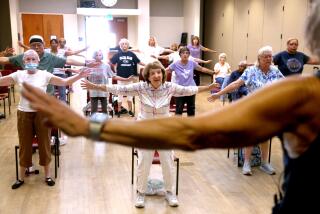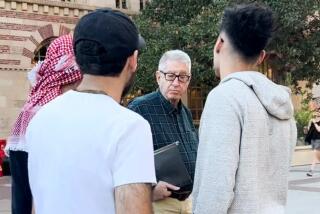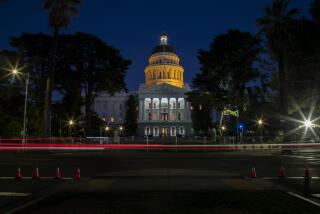On the Media: After Bill Nyeâs collapse at USC, the Web speeds a blame-the-Internet pile-on
USC students didnât move to help Bill Nye, the beloved science entertainer who collapsed right in front of them during a speech on campus. They just sat there, too busy texting and tweeting out news that âThe Science Guyâ had fainted to move a muscle to help.
Or so umpteen reports declared last week â what seemed to be another bit of proof that young narcissists are wallowing in their technology at the expense of their humanity.
What happened with Nye inside Bovard Auditorium remains in significant dispute. But the incident made clear how a single opinion or sliver of information can grow and metastasize as it flits across the Internet â often getting garbled or inflated along the way.
In an age when every scrap of information arrives instantly, itâs worth slowing down to consider how it came to us and remembering that the ubiquity and durability of reports bear almost no relation to how true they end up being.
Otherwise the Nissan Motor Co. would by now have released the oft-reported, never real, âcolor changingâ car. And someone would have produced the long-rumored, much hyped video of Michelle Obama, supposedly standing in church and railing against âwhitey.â
Nyeâs fainting spell and the crowdâs reaction land in a more complicated place because accounts differ about what happened Nov. 16 when the popular 1990s TV personality appeared at USC. Late in his presentation, Nyeâs knees suddenly buckled and he fell. After several seconds, he pulled himself up and returned to the podium, only to begin to slur his speech. He crumpled again. On that much, witnesses seem to agree.
The episode might have received only modest attention but for a couple of students, who saw something rotten at play and got their version out on the Internet, where it took on a lively incarnation all its own. Alastair Fairbanks, a senior majoring in film production, told me that many students around him âseemed more worried about spreading the news of what just happened rather than dealing with the situation at hand, which was his medical condition and what should be done.â
Fairbanks and his roommate, senior Tristan Camacho, contacted the Daily Trojan. But the student newspaper didnât show any interest in a story about student reaction to Nyeâs fainting. (The entertainerâs handlers reported later that he had been exhausted and hungry but had no serious health problems.)
An editor for the student paper explained later that the paper had its own reporter at the speech and she saw the incident, and student reaction, as much more benign.
âBut we said, âNo, this is wrong and someone should know about what happened,ââ said Fairbanks. So he and Camacho called the Los Angeles Times.
They got reporter Corina Knoll, who listened to the duoâs complaint. She, in turn, looked on Twitter and found what appeared to be posts from around the time Nye fainted. So Knoll quoted Fairbanks â perplexed âbeyond reasonâ about the studentsâ apparent lack of response â at the end of an earlier story about Nyeâs collapse.
The reaction began to pour in. âOur society is failing miserably,â said one commenter on latimes.com. âWhatâs wrong with you people out there in California?â wrote another. âAre your minds numb to compassion?â
But several others posted messages adamantly rejecting Fairbanksâ version. Some cited the studentsâ confusion. Others noted that the event staff seemed to have the problem under control. A few denied the students engaged in digital dithering.
The comments provided a more complicated view of the evening, to put it mildly. But it wouldnât have been easy to discern that if you had only read the flurry of blog and news posts that followed.
A blogger at Yahoo! News asserted the crowdâs ânon-reactionâ as a fact, based on several (unspecified) accounts. The story lumped the USC episode with a couple of other notable cases of âcivic indifference,â which the story attributed to âyouthful digital passivity.â Only a later update on Yahoo! noted that at least one witness had an alternative view.
At other sites â none of which appeared to do any original reporting â proportion disappeared. Celebrifi.com ran a big, bold headline, âStudents Keep Tweeting,â and considerable embellishment â claiming Nye had been âweaving in and out of consciousnessâ throughout his speech.
Context also went by the boards. The website the Daily What ran Fairbanksâ comment as the quote of the day, with no other details. Another celeb site, Oh No They Didnât (also known as ONTD, tag line: âThe celebrities are disposable. The content is priceless.â) bold-faced the complaint about the non-responsive audience.
That led to page after page of reaction, much of it outraged. Some attacked the young. Others bashed USC. (âNever have I been so ashamed to be a Trojan,â said one message.) Others counterpunched, accusing Fairbanks of doing nothing to help Nye. (In fact, the student who started it all seemed quite concerned. Sitting in the third balcony when Nye fell, he described how he and his roommate hurried to event personnel to make sure someone would tend to Nye.)
Days afterward, as the furor began to die down, Fairbanks acknowledged that some of the coverage âblew it out of proportion a little bit.â At the same time, he hoped he had provoked some serious thought about how people relate to one another in a world of omnipresent technology.
Nye went on to his next gig. The day after the USC speech, he sent out a message that he would appear at an online town hall with Al Gore on math and science. The update came via Twitter.
Twitter: latimesrainey
More to Read
Sign up for Essential California
The most important California stories and recommendations in your inbox every morning.
You may occasionally receive promotional content from the Los Angeles Times.











